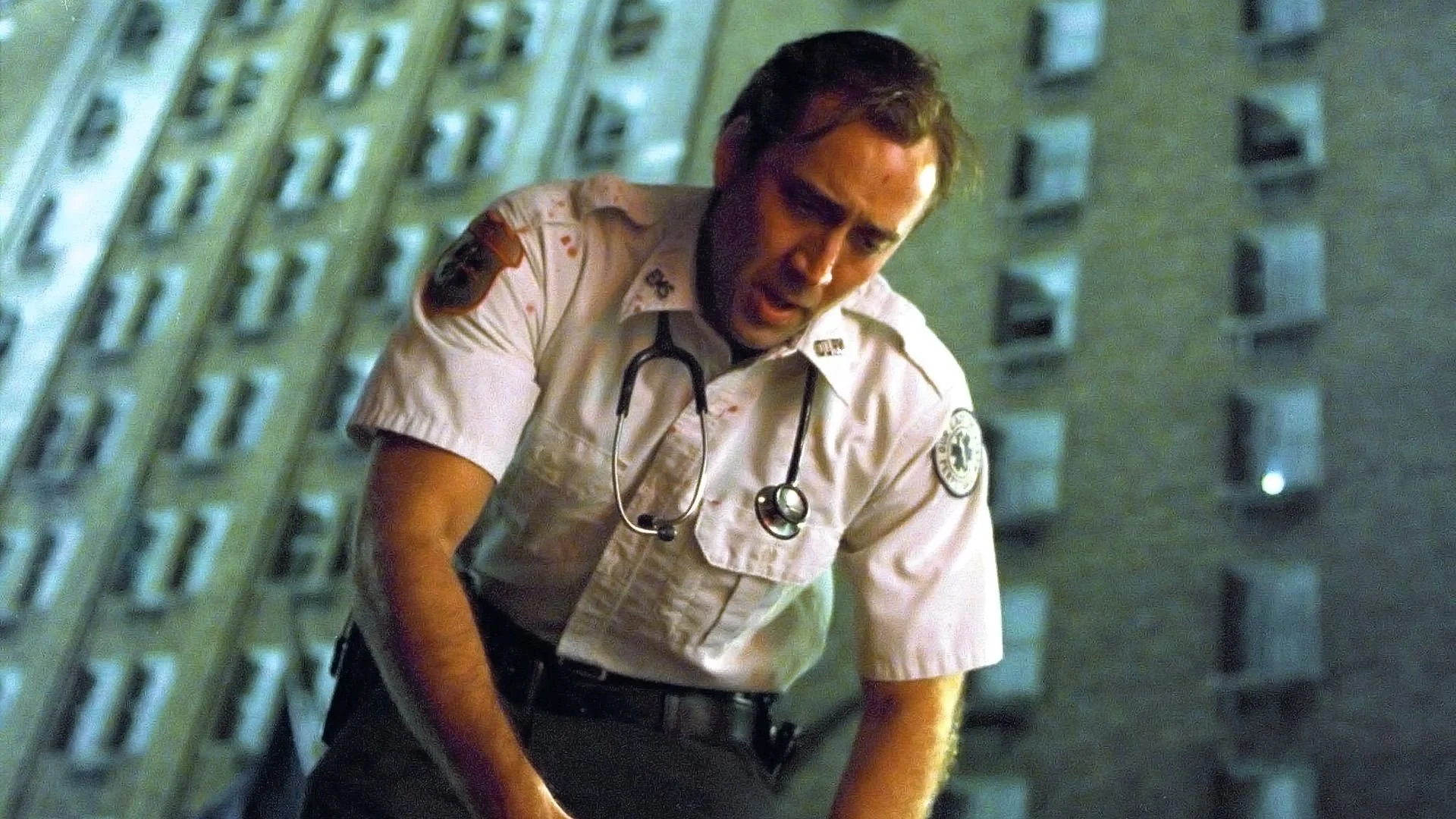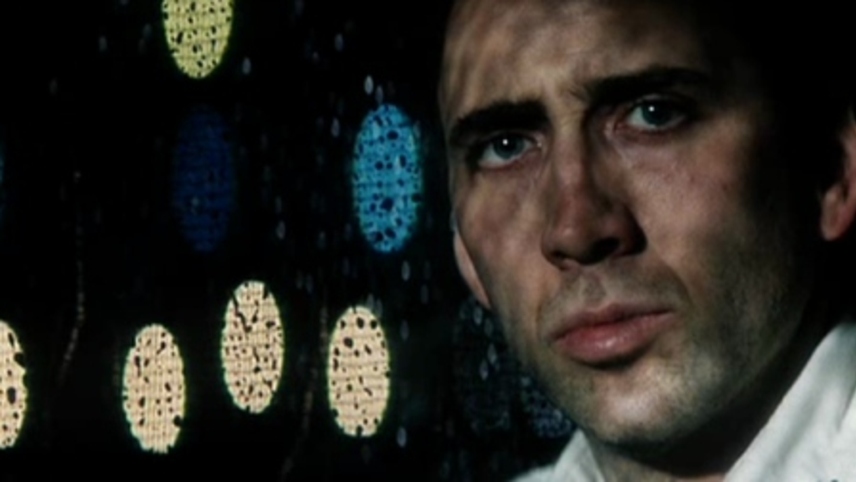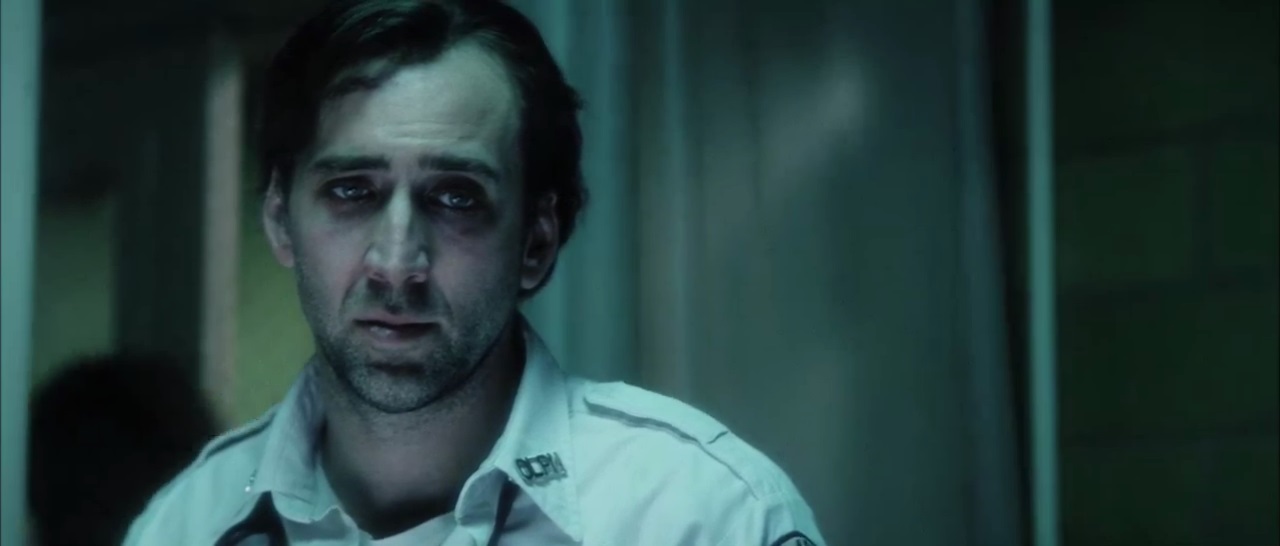“Bringing Out the Dead” does not assert itself as an obviously religious film. and yet, it is borne from the ideological conflict of wrath versus compassion that separates the Old and the New Testament. Here, in the early ’90s, New York is an urban cesspool of sin, destitution, and suffering—it is ready for a biblical cleansing. The film’s hero, the saintly, even Jesus-y paramedic, Frank Pierce (Nicolas Cage), who works tirelessly to save the unfortunate souls, is seen through a religious iconographic filter that blends reality and fiction.
“I had 10 years of ambulances,” director Martin Scorsese told Roger Ebert in a 2012 interview. “My parents, in and out of hospitals. Calls in the middle of the night. I was exorcising all of that. Those city paramedics are heroes — and saints, they’re saints. I grew up next to the Bowery, watching the people who worked there, the Salvation Army, Dorothy Day’s Catholic Worker movement, all helping the lost souls. They’re the same sort of people.”
Schrader’s adaptation of Joe Connelly’s 1998 novel follows a burnt-out and guilt-ridden Pierce over a 72-hour period. It’s a Thursday night, and Pierce’s narration tells us the shift got off with a bang: “A gunshot to the chest on a drug deal gone bad. All the elements were in place for a long weekend: heat, humidity, moonlight.”
Pierce’s poetic narration takes us inside his exhausted and despairing point of view. He is partnered with the over-enthusiastic Larry (John Goodman), the religious Marcus (Ving Rhames), and his former partner, the violent Tom Wolls (Tom Sizemore). Months have passed since Pierce has saved anyone, and he’s haunted by the ghost of Rose, a teenager he failed to resuscitate. Meanwhile, he befriends Mary Burke (Patricia Arquette), the daughter of a cardiac arrest patient who died and miraculously came back to life.

The religious filter of the film and its director is unsurprising, given that Scorsese originally wanted to be a priest and Schrader sought out the profane in art to escape his own oppressive Calvinist upbringing. Sin and redemption is a crux of religion and spirituality, and it has become a recurring thematic modus operandi for both men.
Scorsese’s gangster films are all about flawed characters and the subject of redemption. Nor should we forget that in his opening voiceover of 1974’s “Mean Streets,” Scorsese says, “You don’t make up for your sins in church. You do it in the streets. You do it at home. The rest is bullshit and you know it.” Religion has been an indelible presence in Scorsese’s films that aren’t obviously religious. The ending of “After Hours” is a film about salvation, and “The King of Comedy” revolves around worshipping false idols. And Scorsese’s gangster films lean heavily into temptation, for example, in “Goodfellas,” the seduction of young Henry Hill by the mob that ushers him into a life of crime.
Temptation is a dominant narrative in the Bible, from Adam and Eve taking a bite from the apple in Genesis and Christ’s temptation by Satan in the desert, to God fearing people being taught they should resist bodily and earthly desires. Religion endures through Scorsese’s endless cast of flawed characters, as well as his obvious religious films, “The Last Temptation of Christ,” “Kundun” and “The Silence.”
Meanwhile, Schrader as a solo director, beginning with 1978’s “Blue Collar” and 1979’s “Hardcore,” about a trio of thieves and a father trying to save his missing daughter from the pornographic underworld, to his recent “Redemption Trilogy” (“First Reformed,” “The Card Counter,” and “The Master Gardener”), has obsessively pursued these themes. Schrader and Scorsese’s shared interests underpin their four collaborations: “Taxi Driver,” “Raging Bull,” “The Last Temptation of Christ,” and “Bringing Out the Dead.”
Describing “Bringing Out the Dead” as a film about compassion, Scorsese’s longtime editor Thelma Schoonmaker echoes the tenet of Catholic and Christian belief: “By the grace of God.” Catholics and Christians will also refer to God as compassionate; quick to mercy and slow to anger. So, Schoonmaker’s description tethers the film and her director to religion and spirituality, although Scorsese’s complicity in “Bringing Out the Dead” is evidenced in the way he nurtures a strong, if not oppressive, sensory experience. You can feel Frank’s exhaustion, despair and most importantly, guilt, as if it were your own face glistening with sweat, and it were your own bleary and red-eyed exhausted stare.

In religion, guilt and shame are important levers of control, which hasn’t escaped either Scorsese or Schrader’s attention. Among Scorsese’s cast of flawed characters, Frank is one of the most prominent symbols of guilt. There are, however, two other notable examples that sit outside of Scorsese and Schrader’s collaborations. First, Charlie’s (Harvey Keitel) determination and loyalty to his best friend in “Mean Streets” will manifest as guilt when he fails to save the impetuous Johnny Boy (Robert De Niro).
Then there’s “Cape Fear’s” Sam Bowden (Nick Nolte), a lawyer who exposes his moral failings when he breaks his sacred oath. Tempted by and succumbing to his inner devil, Bowden enters into a type of Faustian pact when he plays the vigilante lawyer who can’t bring himself to help his guilty client, Max Caddy (Robert De Niro), walk free. Charlie and Pierce are the New Testament Jesus-y men with a saviour complex, while Sam symbolises the Old Testament’s ruthless pursuit of moral cleansing. Or maybe less a Faustian pact and, instead, a mimicry of the destroying Angel God set loose on the sinful Egyptians.
This returns us to the Old versus New Testament and Scorsese’s collaborations with Schrader. It’s important to remember, in Christianity, the destroying angel does not have a single identity. The first incarnation in Scorsese’s cinema of this destroying angel was conceived with Schrader. “Taxi Driver’s” vigilante Travis Bickle is introduced cruising through New York in his cab, like an angel sweeping down from the heavens, unleashing a violent, Old Testament-esque cleansing.
“Bringing Out the Dead” finds Scorsese and Schrader transitioning from Old to New Testament. Bickle is the embodiment of the wrathful God, whereas Pierce is the embodiment of a compassionate God. One might read Pierce’s peaceful rescue of Mary from a drug den as a redemption for Bickle’s violent rescue of teenage prostitute Iris (Jodie Foster), itself an echo of “Blue Collar’s” seedy premise.
Scorsese and Schrader, however, remain liberal in their appropriation of Old and New, using the theme of temptation that grew prominent in the second half of their combined filmography. “Bringing Out the Dead” is interpretable as a reimagining, in part, of Christ’s temptation in the desert. Frank is complicit in Marcus’ charlatan stunts, pretending to heal the sick through God’s will. He goes along with Woll’s plan to beat up Noel (Marc Anthony), a regular patient at Our Lady of Perpetual Mercy Hospital, who causes havoc on the streets by smashing car windows and threatening bystanders with a broken glass bottle.
Woll is simultaneously Old Testament wrath and Satan tempting Pierce. In “Bringing Out the Dead,” the desert of Christ’s confrontation with Satan is recast as New York City, where Pierce cruises around in his ambulance. He’s a saintly figure resisting the excitable, lustful, violent charlatan devils he’s partnered with. Or, “Bringing Out the Dead” is “The Last Temptation of Christ” goes to the big city.

It’s difficult for any Scorsese film to wrestle itself free of the conflict between Old and New Testament, because from a formative age, Scorsese was trapped between the church and the violence on the streets. He was exposed to spiritual ideas of compassion, redemption and salvation, but hecwalked to school along pavements covered in broken glass and blood. Schrader was a complimentary creative voice, who through his own oppressive relationship with religion, could appreciate Scorsese’s sentiment, “You don’t make up for your sins in church. You do it in the streets. You do it at home. The rest is bullshit…”
Scorsese and Schrader’s collaborations and their solo work are filled with a deep-rooted cynicism when it comes to redemption. They emphasize our relationship with religion and its ideas outside of the church. This response might be attributable to the sacrament of penance and learned patterns of behaviour for Catholics, who are not taught to forgive themselves. Whether or not Pierce is a Catholic, his guilt over Rose’s death is irreconcilable, and by the end of “Bringing Out the Dead,” he commits a mortal sin when he euthanizes Mary’s father. Pierce still needs to be understood as a redemptive character in Schrader and Scorsese’s collaborations—his peaceful rescue of Mary and the mortal sin motivated by compassion cannot be meaninglessly cast aside.
Pierce is a unique character who may not be aware that he symbolizes the values we subscribe to God. It’s important to remember that morality, compassion, and empathy come from inside us, and we have given ownership of our precious, even sacred, humanity to a collective idea of God. Frank’s mortal sin and theoretical redemption of Travis in his saintly actions and resistance to temptation is a thoughtful and honest challenge to humanity’s hierarchical relationship with religion and God, who was more likely made in our image. If Frank isn’t conscious that he forgives himself, which is likely, and he fails to comprehend the significance of his actions, he ensures “Bringing Out the Dead” is not a passive appropriation of religion we’ve traditionally seen from Scorsese and Schrader. Instead, it represents a proactive critique that engages more substantially with the subject.
The film’s dark and grimy world, which is difficult to digest, strangely offers an eternal glimmer of humanity and hope. Scorsese and Schrader cunningly use this aesthetic approach as a trojan horse to pursue the deeper thematic critique “Bringing Out the Dead” engages.

“Bringing Out the Dead’s” final scene is a beautifully orchestrated rumination on human guilt and suffering. Pierce goes to Mary’s apartment, and when she opens the door, he begins hallucinating. Seeing Rose standing before him, he apologizes to her. She says, “It’s not your fault. No one asked you to suffer.” Departing his hallucination, he follows Mary into the apartment. They lie down on the bed together and are encompassed in a bright light that signals that the characters we have come to know have undergone a metamorphosis—they have shed their suffering. Pierce has made peace with his guilt, and Mary has accepted her father’s passing.
Rose’s words, however, haunt this beautiful and sensitive moment. They echo like a warning—with compassion comes suffering. Her words also remind us that while we habitually look outward to spiritual beliefs, fate, and other all-encompassing forces, these hierarchical constructs are naive, and we are forever running away from things that are part of but are not greater than us. Instead of ideas around redemption and sin, temptation, and guilt empowering us through the development of self-awareness and emotional intelligence, we choose to deny ourselves self-compassion that escalates our suffering.




